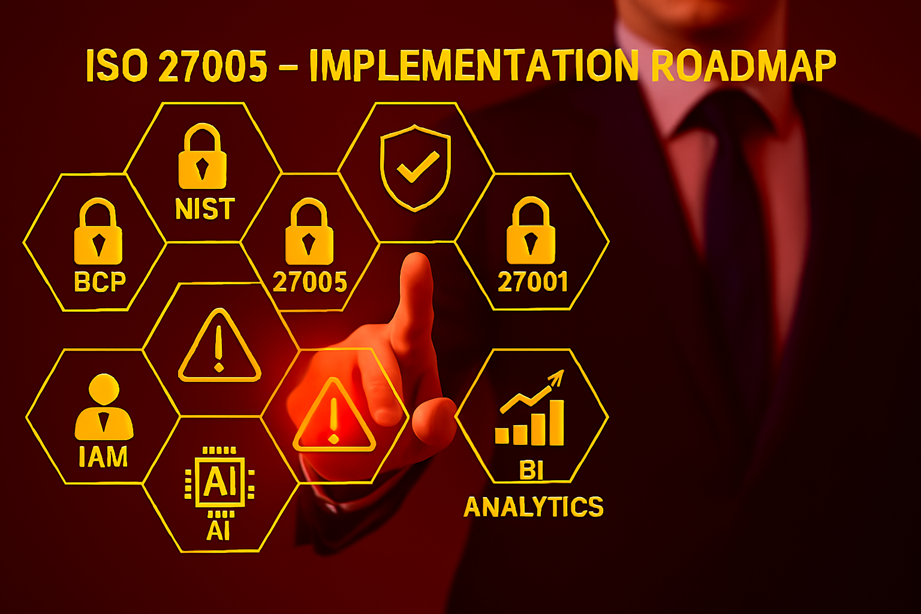
Status: Final Blueprint Summary
Author: Shahab Al Yamin Chawdhury
Organization: Principal Architect & Consultant Group
Research Date: August 21, 2024
Location: Dhaka, Bangladesh
Version: 1.0
1.0 Executive Summary & Strategic Imperative
This document provides a summarized blueprint for implementing the ISO/IEC 27005:2022 standard for information security risk management. The core objective is to transform risk management from a cost center into a strategic, value-generating function.
The Financial Imperative:
A robust risk management framework is a strategic necessity driven by severe financial consequences of security failures.
- High Breach Costs: The global average cost of a data breach has reached USD 4.88 million. Costs are significantly higher in regulated industries like healthcare (USD 9.77 million) and finance (USD 6.08 million).
- Human & Third-Party Factors: The human element is a factor in 68% of breaches, and incidents involving third parties have increased by 68%.
- Key Threat Vectors: Stolen credentials remain the most common attack vector (16% of incidents), while ransomware and extortion are involved in approximately one-third of all breaches.
2.0 The ISO Framework Ecosystem
ISO 27005 operates within a symbiotic ecosystem of standards:
- ISO 31000 (The Philosophy): Provides a high-level, generic framework for Enterprise Risk Management (ERM) across all risk domains.
- ISO 27001 (The Mandate): The certifiable standard for an Information Security Management System (ISMS) that requires a formal risk assessment and treatment process.
- ISO 27005 (The Methodology): Provides the detailed, step-by-step guidance on how to conduct the information security risk management mandated by ISO 27001.
3.0 The 4-Phase Implementation Roadmap
This roadmap outlines a continuous, four-phase lifecycle for implementing ISO 27005.
Phase 1: Context Establishment (Foundation)
This phase sets the strategic foundation and rules for the risk management program.
- Key Activities:
- Define the scope and boundaries of the risk management process.
- Identify all internal and external stakeholders and their requirements.
- Establish clear and objective risk criteria, including impact scales, likelihood scales, and the organization’s official risk appetite.
- Key Deliverables:
- Scope and Context Document
- Risk Criteria Document
Phase 2: Information Security Risk Assessment (Discovery)
This phase involves the systematic identification, analysis, and evaluation of risks.
- Key Activities:
- Risk Identification (Dual-Pronged Approach):
- Asset-Based: Inventorying assets and identifying their associated threats and vulnerabilities.
- Event-Based: Developing plausible, threat-intelligence-informed risk scenarios (e.g., ransomware attack, insider threat).
- Risk Analysis: Determine the level of each risk, preferably using a quantitative model like FAIR to express risk in financial terms (Annualized Loss Expectancy).
- Risk Evaluation: Compare analyzed risks against the predefined acceptance criteria to prioritize them for treatment.
- Risk Identification (Dual-Pronged Approach):
- Key Deliverables:
- Comprehensive Asset Register
- Risk Scenario Library
- Prioritized Risk Register
Phase 3: Information Security Risk Treatment (Action)
This phase translates analysis into a concrete action plan to address unacceptable risks.
- Key Activities:
- Select one of four risk treatment options for each prioritized risk: Modify (mitigate), Retain (accept), Avoid, or Share (transfer).
- For risks being modified, conduct a cost-benefit analysis to ensure a positive Return on Security Investment (ROSI) for selected controls.
- Formulate a detailed Risk Treatment Plan (RTP) documenting actions, responsibilities, timelines, and resources.
- Develop the Statement of Applicability (SoA), a mandatory document for ISO 27001 that justifies the inclusion or exclusion of Annex A controls.
- Key Deliverables:
- Risk Treatment Plan (RTP)
- Statement of Applicability (SoA)
Phase 4: The Continuous Lifecycle (Sustainability)
This phase ensures the risk management process is an ongoing and adaptive part of the organization’s operations.
- Key Activities:
- Risk Communication: Develop and execute a plan to communicate risk information to all relevant stakeholders.
- Monitoring and Review: Continuously monitor for changes in the risk landscape and conduct formal reviews of the risk assessment annually or upon significant change.
- Continual Improvement: Use monitoring outputs to update documentation and refine the ISMS, following the Plan-Do-Check-Act (PDCA) cycle.
- Key Deliverables:
- Risk Communication Plan
- Risk Monitoring Reports
- Updated Risk Documentation & Management Review Records
4.0 Critical Success Factors
- Best Practices to Adopt:
- Secure active executive sponsorship from the start.
- Form a cross-functional team including representatives from legal, HR, finance, and business units.
- Adopt a phased implementation, starting with a critical scope to demonstrate early success.
- Foster a risk-aware culture through continuous training and communication.
- Common Pitfalls to Avoid:
- Lack of genuine executive buy-in and resource commitment.
- Poorly defined scope (either too broad or too narrow).
- Creating “paper-only” compliance documents that don’t reflect operational reality.
- Underestimating the skills, resources, and administrative effort required.